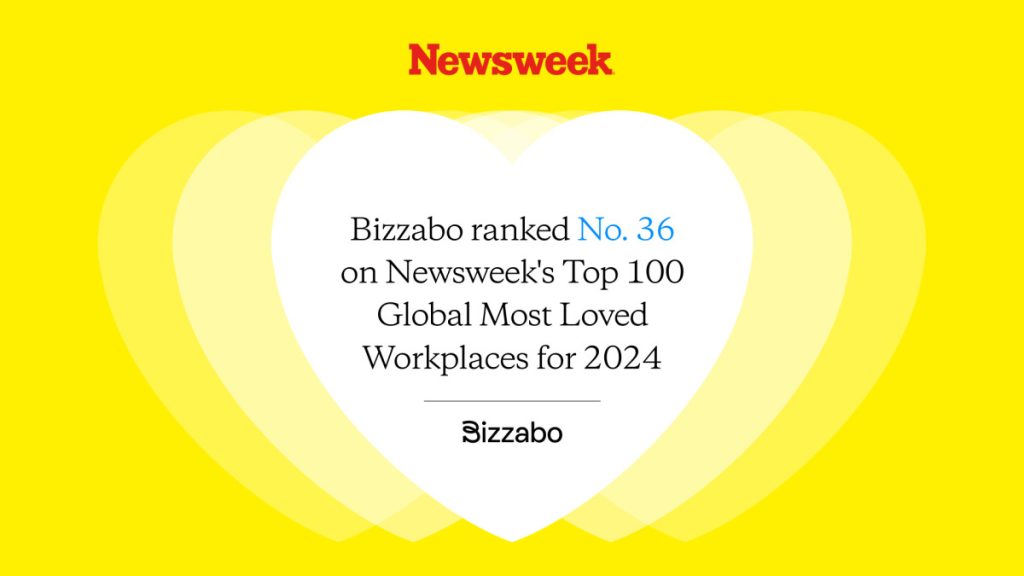Event Strategy: The Guide for 2024 and Beyond


Event professionals have a million things on their plates at any time. They’re determining event goals, mapping out a killer event strategy, building the event website, sending out event marketing emails, deciding on what type of event planning software to use, and making sure to hit event goals — and that’s just the beginning.
As we enter 2024, in-person events are more important than ever. According to Bizzabo data, 97% of B2B marketers believe in-person events play a critical role in achieving business outcomes. Additionally, 72% of event organizers agree that in-person events are a crucial part of their organization’s overall marketing strategy.
Even still, our survey found that 68% of event organizers plan to have a virtual component at their next onsite event. PCMA research uncovered similar findings: One of two event planners planned hybrid events so attendees could attend according to their preferences.
Meanwhile, Forrester found that B2B companies allocate as much as 40% of their budgets to events!
Add it all up, and organizations that aspire to be at the top of their industry must invest in their event strategy. It’s that simple. In this guide, we’ll walk you through the details of building an event strategy, event strategy examples, the five steps you need to create and execute your event strategy, and so much more.
The 5 Stages of Strategic Event Planning
As event professionals know too well, planning and executing an event is a massive undertaking. To help you keep track of every step of the event-organizing process, we’ve put together a comprehensive event strategy guide focused on these five steps:
- Plan the Event
- Launch the Event
- Promote the Event
- Manage the Event
- Wrap Up and Measure Event Success
But first: What is an event strategy? An event strategy is a data-driven, intentional, measurable plan that outlines what your organization expects to accomplish through events and how you will achieve and measure those goals.
Your event strategy should cover the types of events you want to put on, the tools in your event tech stack, the audiences you want to engage, and the metrics you’ll track to gauge event success.
Events have never been more critical. After several years of avoiding in-person events or only attending virtual events, attendees are ready for the evolution of events. Is your strategy ready for what audiences expect in 2024? Let’s take a look.
Step 1: Plan the Event
The planning stage is arguably the most critical part of the process. After all, it’s the foundation upon which the rest of the event lies. In this section, we’ll look at how you can build a sound foundation — from setting event goals to choosing an event type and format.
Set Event Goals
The first and most crucial step of your event strategy is determining why you’re organizing an event in the first place. What are your event goals? Here are some common goals you may want to include in your event strategy:
- Increasing brand awareness
- Generating leads
- Improving customer/organization relationships
- Educating prospects
- Educating employees
- Driving more activity in target accounts
- Retaining or delighting customers
- Driving sales opportunities in target accounts
“As much as we’ve changed and improved technology to be able to connect with people, nothing yet replaces real-time, face-to-face interactions in terms of creating new opportunities.”
Hugh Forrest
Director, Interactive
SXSW
There are many reasons to organize events, but be sure to choose a few measurable goals and prioritize them so you can market your event and measure success more easily.
Once you’ve solidified your event’s goal or goals, it’s time to make sure that they are SMART and CLEAR. There’s nothing worse than setting a goal but not having the mechanics to properly measure whether you’ve achieved that goal after the event.
Master the art of measuring event ROI: “The Guide To Event Marketing Attribution & Measuring Event ROI.”
Pinpoint Event Success KPIs
Your event goals will inform how you measure your event’s success. Just as there are many event goal types, there are many event KPIs you can use to measure success. To illustrate, here’s a list of some of the most popular event KPIs from a demand generation funnel perspective:
- Registrations
- Gross revenue
- Attendee satisfaction
- Attendee engagement
- Cost-to-revenue ratio
- Number of qualified sales leads
- Sales pipeline created
In comparison, when looking at your KPIs from an account-based marketing (ABM) perspective, you’ll want to surface metrics that show engagement across your target accounts. Each metric you choose should capture the level of engagement. Here are a few examples:
- Registrations from target accounts
- Gross revenue from target accounts
- Attendee satisfaction from target accounts
- Attendee engagement from target accounts
- Qualified sales leads from target accounts
- Sales pipeline created from target accounts
Want even more KPIs and metrics to track at your next event? Read “23 Important KPIs for Measuring Event Success”
Strategize Your Event Budget
The next step in your event strategy is to determine what resources at your disposal to turn those goals into reality. In other words, it’s time to draft an event budget.
Align with your leadership to understand what funds are available to you. After that, create a rough event budget — itemizing each element you think you’ll need along with a description, estimated cost, and actual cost.
Depending on your chosen event format, your event budget will vary. Here are some items to include:
- Event tech software
- Video production software
- Security and staff
- Badges and onsite services
- Food service and other vendors
- Printed and other materials
- Speaker fees
- Transportation and hospitality fees
- Venue rental fees
- Thank you gifts
Understanding your budget will help you determine the best channels for promoting your event and the best management tools.

Set Event Ticket Pricing
As part of your budget conversation, you’ll probably discuss ticket pricing. Assuming you aren’t hosting a free virtual event or webinar, the best way to price your tickets is to work back from your revenue goals. If you have a particular revenue goal in mind, consider what types of ticket pricing tiers you can use to achieve that goal and what options you have for free tickets (e.g., virtual), subsidized tickets for different socioeconomic classes, and so on.
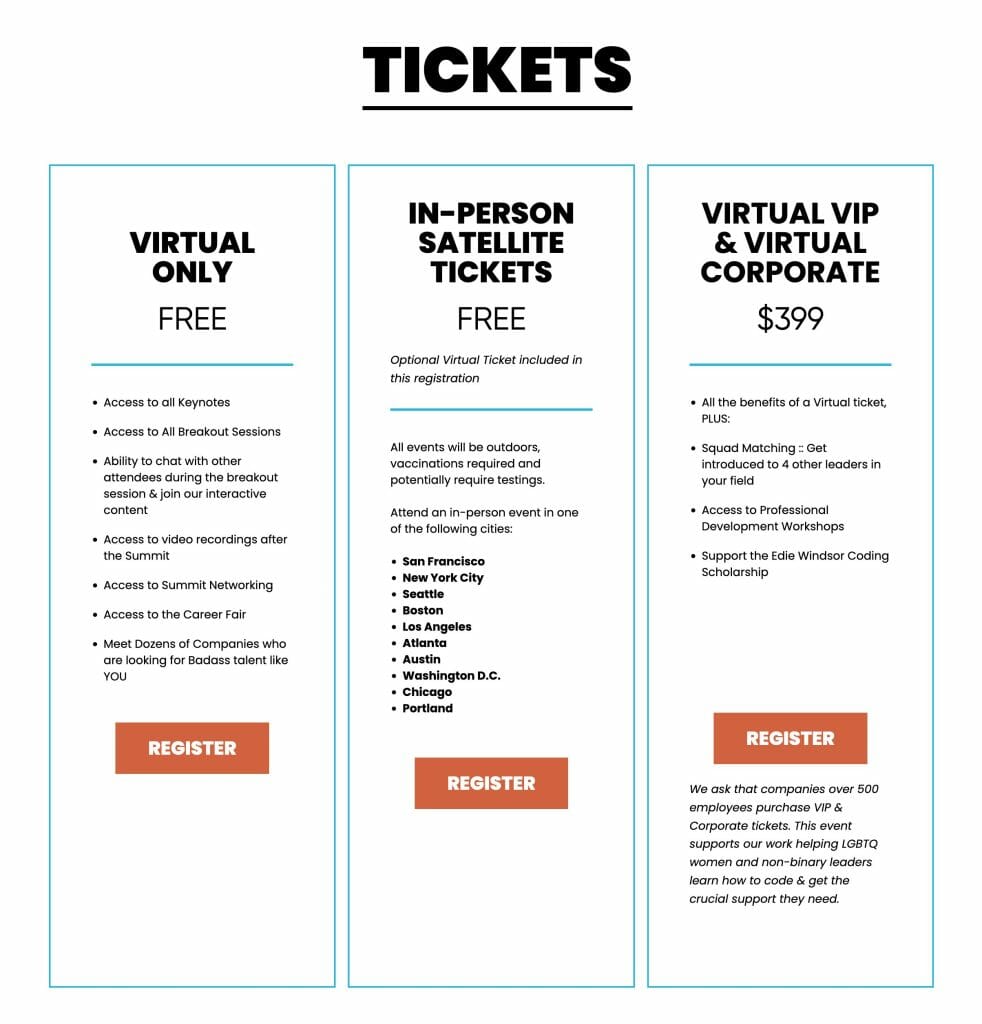
Master the art of ticket pricing strategies: “In-person, Virtual, and Hybrid Event Ticket Pricing Strategies.”
Choose the Right Event Management Tools
Event planning is complex. Luckily, event planning tools make everything much more manageable. No matter what your goals, KPIs, budget, or team size, you’ll want most — if not all — of the following tools to make event planning and execution more manageable and better for everyone involved:
- Event registration software
- Event planning and analytics software
- Event marketing software
- Onsite event registration software
- Video production software
- High-tech wearables
- Mobile event app
Whether you decide to use a collection of platforms or an all-in-one event management solution, make sure that your event tech stack offers important features aligned with your event goals. For example, if you want to optimize attendee engagement and capture key metrics, you want to invest in a solution that provides third-party integrations with your existing platforms, plus options for onsite registration and a mobile-friendly event experience.
For instance, you may want to seamlessly send data from your event platform to Salesforce or HubSpot. In either scenario, having event software integrations will be essential. Integrating your event platform and your CRM allows better visibility into all your prospect and customer activities. Additionally, integrating your event software with your CRM empowers your sales team with more data they can use to curate their conversations and messaging and to better align with your overall event strategy.
Below is an example of how Bizzabo can integrate event data from contacts to leads into a CRM like Salesforce.

Create a Strategy for Onsite Registration
On the attendee side of the event, first impressions are critical. A plan (and contingency plan) for your onsite registration process will ensure a seamless and delightful experience for your attendees.
For example, you may want to review event platforms that can build onsite kiosks for attendees. Although this allows for a faster check-in experience, you may still want technical support staff in case of an outage or other troubleshooting issues. A thoughtful and intentional onsite experience allows you to quickly capture necessary event data for analysis such as the following:
- Total number of attendees
- Total checked-in attendees
- Total checked-out attendees
- Total attendees with no status
- Real-time check-ins
Decide What Audience Engagement Looks Like
Once your attendee has checked in, you’ll want to make the event as engaging and accessible as possible — whether you’re hosting a large conference or a small satellite event. An easy way to do this is by investing in a mobile event experience, which allows attendees to engage with your event and each other in real time in the palms of their hands. A branded, in-app event experience can increase brand equity, drive attendee engagement, grow your event community, and help sponsors engage with their audience more effectively.
Another idea for boosting engagement is to partner with an event software partner that offers high-tech wearables. Want to encourage networking and contact sharing between attendees and sponsors? With high-tech badges, you can take your event experience to the next level and boost engagement, give sponsors better data, and make your event the talk of the town.
Do you know what the five Cs of event management are? Read “What is Event Management? The Ultimate Guide” to find out!
Settle on Event Branding
We’ve covered a lot of the preliminary groundwork for planning an event. But there’s one more piece of the puzzle we have to cover before building out the infrastructure of your event: your event’s brand.
Everything about your event — from the website to the promotional emails to the onsite decor and food served — should be an extension of your event’s brand.
The critical question to ask yourself is this: What feeling do I want to convey to attendees? What is the experience I want them to have? What do I want attendees to leave my event thinking about or talking about?
A great example of an event with a strong brand is Social Media Marketing World, arguably the most prominent social media event in the world. Everything about the event’s online and offline presence conveys adventure and fun. Social Media Marketing World creates a brand consistent with the event experience, allowing attendees to feel continuity from one year to the next.
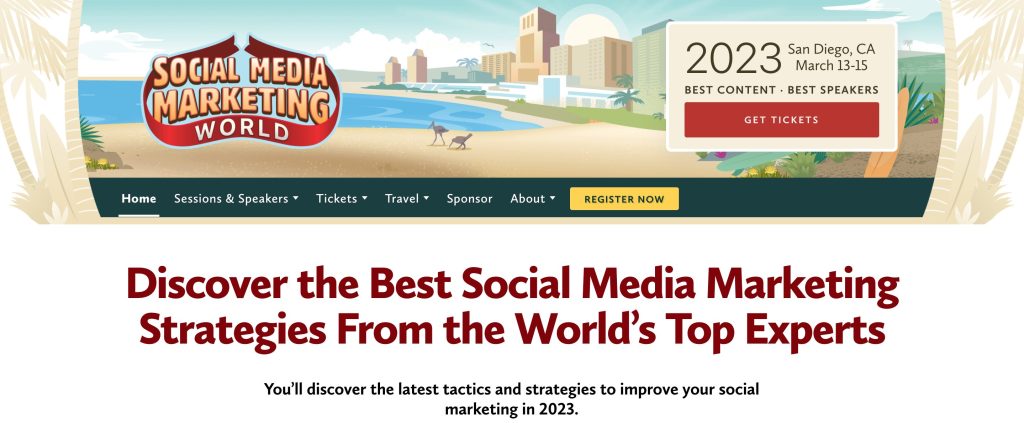
Source: Social Media Marketing World
Although not every brand needs to convey adventure and fun, every event should present an experience to the attendees. Failure to deliver an experience is as big of a mistake as not setting proper event goals.
Another excellent example of an annual event that delivers an unforgettable brand experience is SXSW. From year to year, attendees know that there will be next-level brand activations, an expo hall filled with swag and experience, and sessions to talk about for months to come.
“Spend your time worrying about the attendee. What experience are we trying to create for that attendee? What journey are we trying to create for them?”
Colleen Bisconti
VP, Events and Experiences
IBM
Want more inspiration for building a strong event brand? Check out these “12 Events That Deliver Unforgettable Attendee Experiences.”
Build Your Event Website
At this point, it’s time to build your event website — the storefront for your event. In most cases, it’s the first thing prospective attendees and stakeholders see. For the best results, ensure your event website has a strong vanity URL for social sharing, is accessible and mobile-friendly, and communicates the mission of your event. Your event website should include the following:
- Date, time, and location
- Agenda
- Speakers
- Reasons to attend
- FAQ
- Clear registration CTA
- Sizzle reel from last year’s event (if possible)
- Images from last year’s event (if possible)
- Content from last year’s event (if possible)
Check out how GitHub nails its event website below:
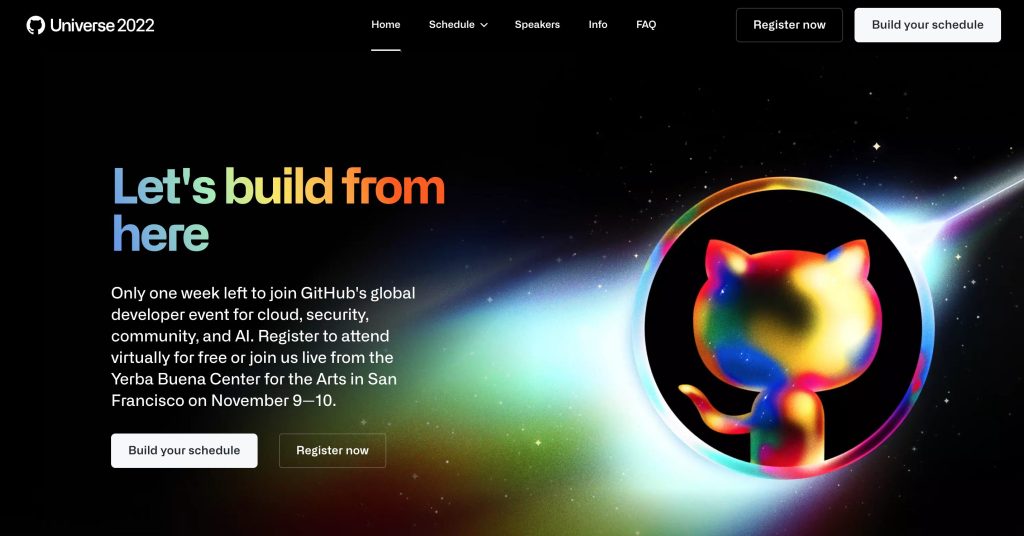 Source: GitHub Universe
Source: GitHub Universe
Depending on your event, it may be worthwhile to create a pre-event “save the date” website before you have the rest of your digital event infrastructure built out. A pre-event website can be as simple as a landing page with information about your event.
In fact, many events flip a switch the moment their event is over to encourage people to register for next year’s event. HubSpot, for example, did this the moment INBOUND 2022 was over. The INBOUND event site now features a retrospective and CTAs to register for next year.

Create an Event Hashtag
Make it easier for attendees to connect with other fans by using an event hashtag. If you don’t choose an event hashtag, other people will choose them for you. If you don’t choose and share your event hashtag, you’ll miss the ability to track what people say about your event, opportunities for repurposing user-generated content (UGC), and owning the conversation.
One common best practice is to reflect the year with the event name. This can be especially helpful if someone already has the root of your event hashtag or if you plan on using your event hashtag in the future. Make it easy, make it memorable, and keep it on brand.
Here are some examples of great annual event hashtags:
- Event Tech Live: #ETL22
- INBOUND: #INBOUND22
- Google I/O: #GoogleIO22
- Social Media Marketing World: #SMMW22
- Dreamforce: #DF22
Start Outreach to Partners, Speakers, and Sponsors
No event exists on its own. To get the most out of your event, you need to enlist the support of partners, speakers, and sponsors. The sooner you begin reaching out, the easier it will be to lean on those names and spread the word about your event further down the line.
As you begin formulating your outreach strategy, determine why you’re reaching out to each potential stakeholder. Some questions to explore include the following:
- Do you need help marketing your event?
- Does the product or business values of the sponsor/partner align with yours?
- Do you need sponsors to help mitigate the cost of planning the event?
- Are you trying to attract more attendees with a marquee name?
For example, in 2022, Bizzabo partnered with Skift Meetings for a webinar on event data intelligence and how to turn insights into action. Bizzabo VP of Global Events Devin Cleary, Bizzabo Senior Event Content Manager Rachel Heller, and Skift Branded Content Editor Angela Tupper spoke at the event, which aimed to help event professionals leverage data to improve events. (Note: At the live event, Skift’s editor-in-chief Miguel Nunes, stepped in for Tupper.)
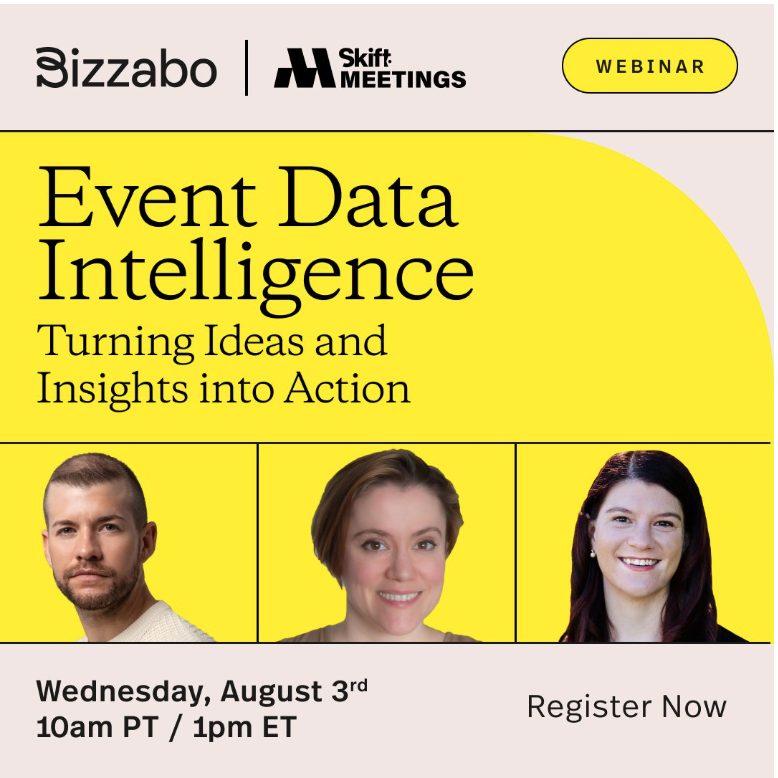
To help you organize outreach to potential event partners, create a list of stakeholders. Include the name of the stakeholder, the type of stakeholder they would be, the reason you’re reaching out to them, the contact’s name, the contact’s email address, and the status of their responses. You can then begin personalized outreach campaigns to start conversations.
Here’s a list of the critical information to include in this area of your event strategy:
- Stakeholder name
- Stakeholder contact information
- Stakeholder role (speaker, sponsor, partner)
- Reason/explanation for inclusion (e.g., major influencer, strategic partner, past sponsor)
“At Forbes, we really try to guide the sponsor experience so that they’re creating meaningful activations that can actually build the event.”
Chardia Christophe-Garcia
Executive Director, Audience & Community Marketing
Forbes
Prepare Your Go-to-market Teams
Lastly, take your strategy to your go-to-market teams. You must convey your event’s goals, KPIs, vision, and other information to your sales and customer success teams, so they are prepared well in advance of the event’s launch. This will enable them to do proper outreach and drive registrations.
As part of your GTM strategy, you should consider gamifying the registration process. Offer a $500 gift card to whichever rep brings in the most registrations, and be sure to set a minimum number of registrations to make the reward viable.
Need more guidance for activating and enabling your go-to-market teams? Download The Event Organizer’s GTM Mobilization Kit.
Create a Contingency Plan
If there’s one thing event organizers learned from the COVID-19 pandemic, it’s that creating a contingency plan is more than optional — it’s table stakes. According to the Event Preparedness and Resilience Survey Report, 86% of event planning teams say their risk management processes are “mature” or “emerging.” However, only 16.6% of teams say they are “mission-ready” to respond to whatever event challenges come their way.
Do yourself, your attendees, and your team a favor and prepare a comprehensive plan for when the impossible becomes reality — whether that’s a natural disaster, pandemic, or other potentiality.
Explore more ways to build a future-proof contingency plan: Event Contingency Planning: How To Build a More Resilient Event Strategy.
Step 2: Launch the Event
Now that your event infrastructure is in place, it’s time to launch your event! Start by sending out an on-brand email from your CRM that is concise but excitement-inducing with information about your event and a clear registration call-to-action.
Although you may want to send the announcement email to your entire list, we recommend creating thoughtful segments and unique email content for each segment. Some segment examples include the C-suite, marketers, salespeople, customers, vendors, sponsors, and so on.
Check out this great announcement email from SXSW:
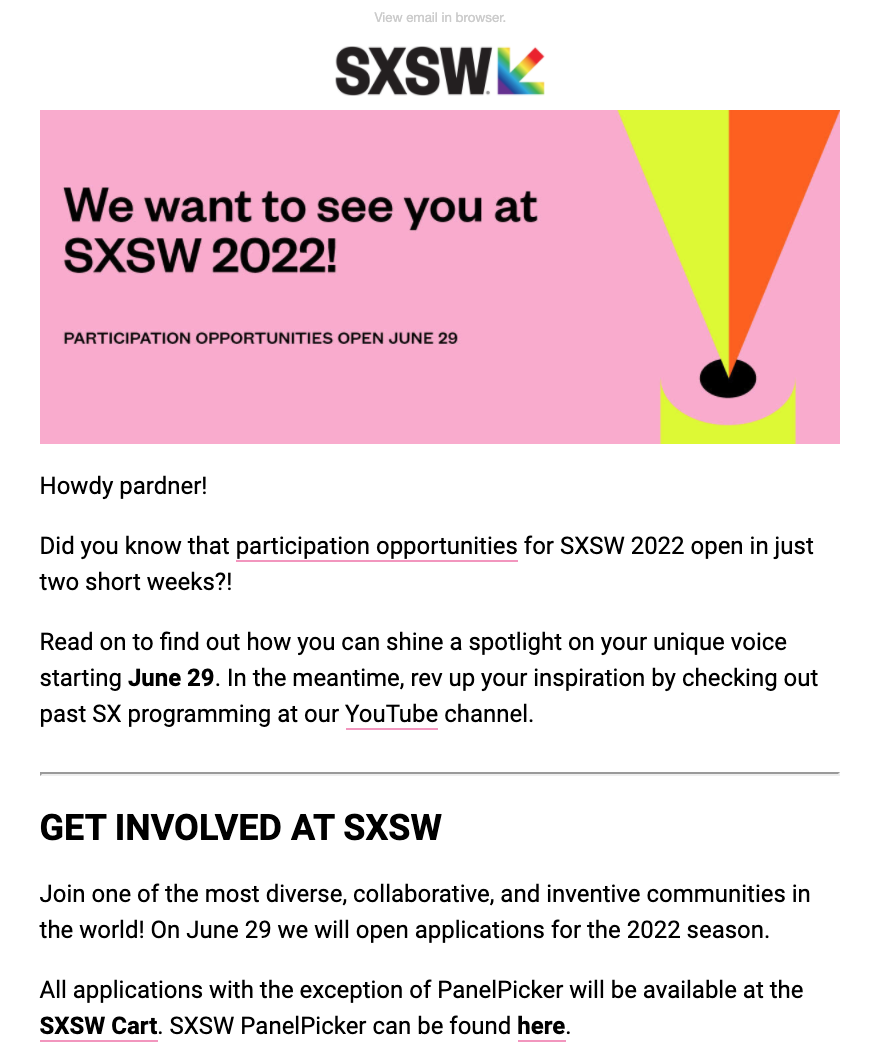
News Announcement and Press Releases
To market your event effectively, you have to take a multi-faceted approach on your website and through other channels.
One of the first things you should create is a news article on your website’s press or news page announcing your event. Then, publish a press release to expand your event’s reach. As you begin writing the press release, focus on what makes your event unique. Is it the speakers? The mission? The topics you’re covering? Remember that prospective attendees and journalists may receive automatic Google Alerts depending on the key terms you include.
Press release platforms offer targeting based on industry, among many other criteria, and different PR networks come with different price tiers and analytics functions.
Prioritize Social Media and Co-marketing
Now that your event is live, it’s time to start marketing on social media. Devise clever copy and images to draw attention to your event, use your event hashtag, and post away!
Create posts that focus on different aspects of your event. For instance, one series of posts can focus on the amazing speakers at your event, and others can focus on your partners, different sessions, discounts, and anything else that makes your event stand out.
And don’t forget about the power of video. While promoting our Now & Next event — not to mention most of our events — we used “talking head”-style videos to add a human element to the ask.
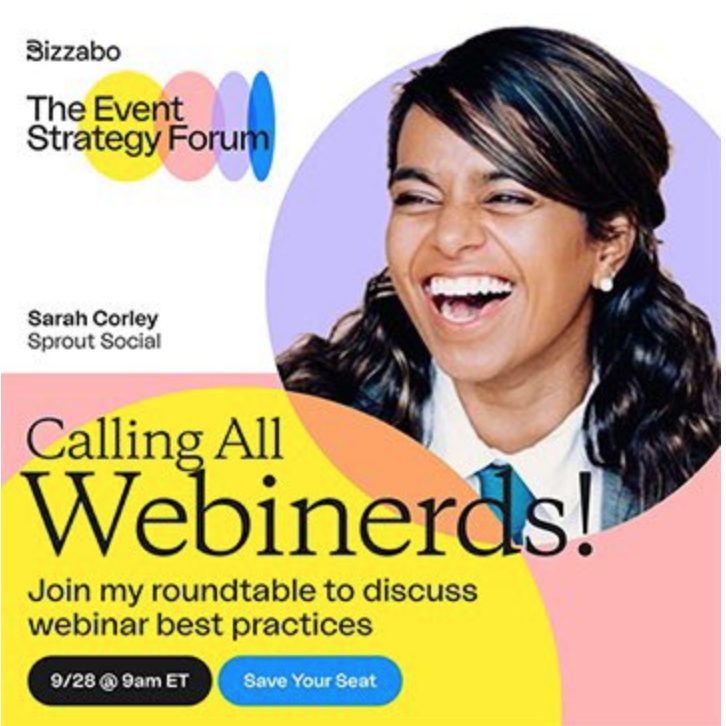
It’s a good idea to send event sponsorship packets to your partners containing copy, images, and promo codes that they can share. To help your partners out, even more, segment the materials that you give them by social media network (e.g., Instagram, Twitter, LinkedIn), newsletter, and even blog articles. Each of these different mediums may call for different content lengths and styles, so you’ll have to adjust accordingly.
Here is another example of a social post that focuses on why folks should attend:
Activate Your GTM Teams
Remember when we mentioned you need to prep your go-to-market teams? Now is the time to activate them! Be sure they have email templates, unique links, and more to drive registrations and take part in the drive to boost attendance. In fact, we recommend holding a call with your GTM teams to give them the rundown again, ensure there are no questions, and keep everyone on the same page on goals, KPIs, and timelines.
Step 3: Promote the Event
Next up, it’s time to keep your event at the top of people’s minds with event marketing. This is where the event promotion stage — which is critical for driving registrations and building excitement — begins. You want to set a clear cadence for email promotion, so you don’t overwhelm your audience and keep your event top of mind. Here are several email promotion examples to consider as you build out your event strategy:
Super Early Bird Pricing: EMS
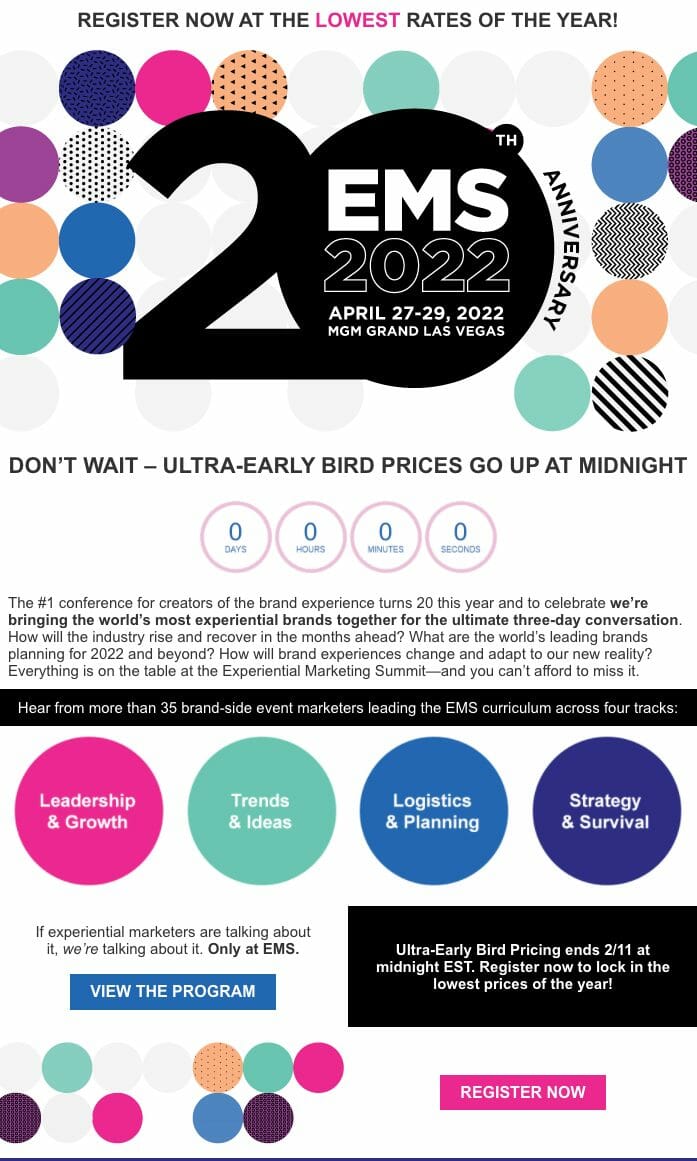
Speaker Spotlight: Litmus
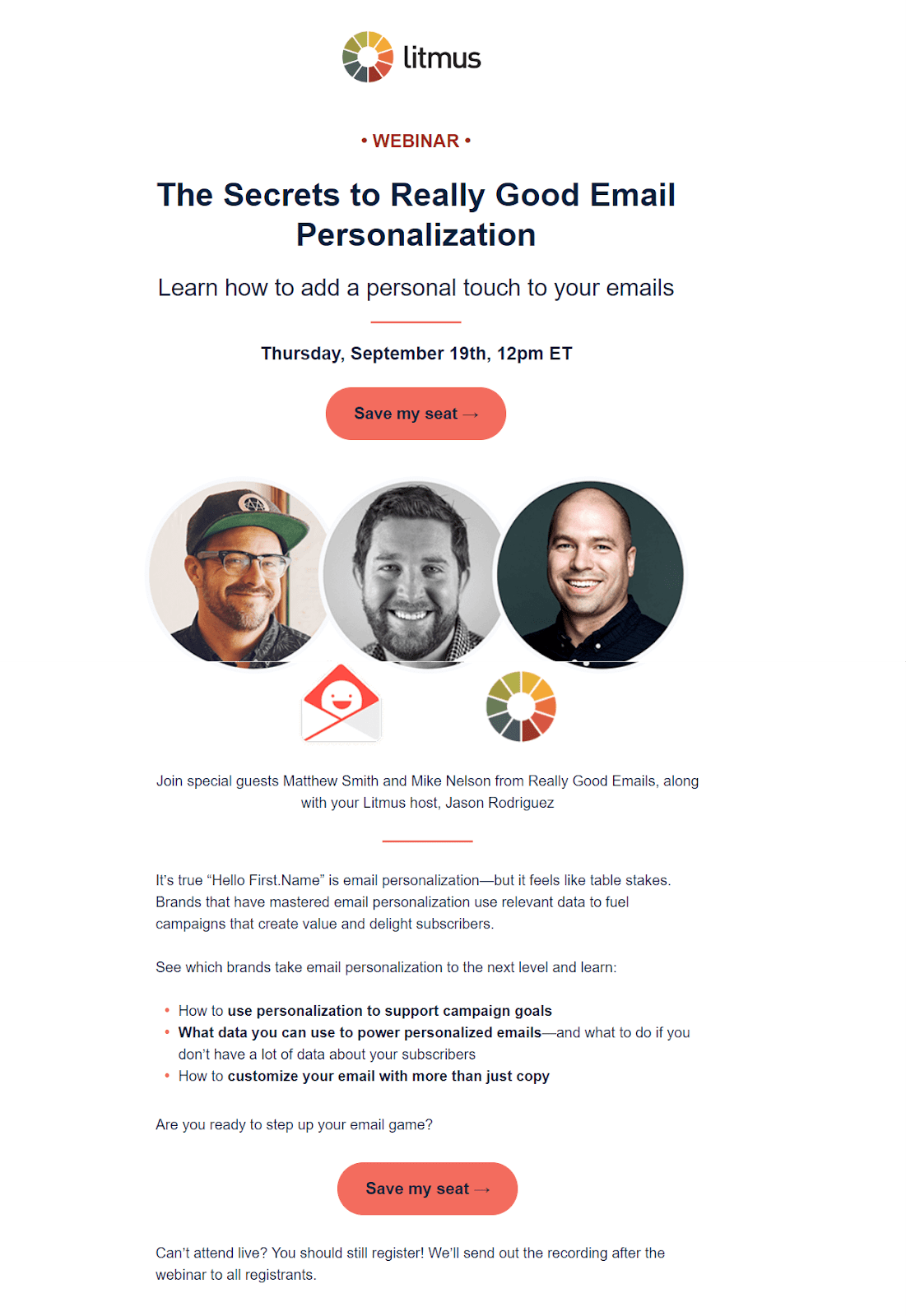
Video: Influitive Advocamp
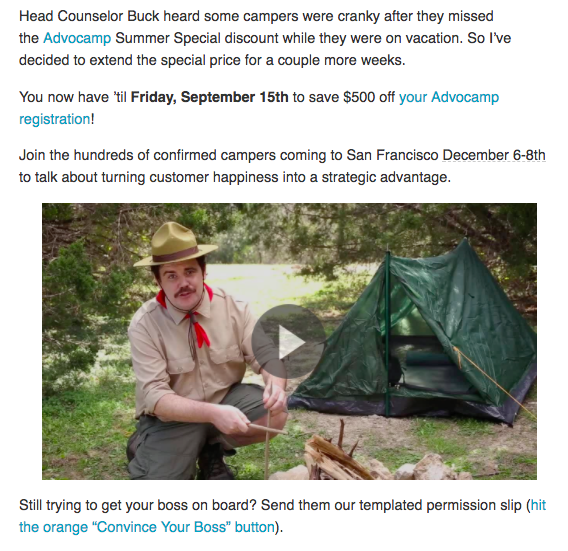
You can find more exceptional event email marketing examples here.
Level Up Social Media Event Promotion
Similar to the launch phase of the event, you want to promote your event through social media and co-marketing initiatives up until the event date. Here are a few tips:
- Don’t overdo it on posts, or you’ll frustrate your followers and could create a swell of unfollows.
- Don’t forget to plug promo codes where applicable too.
- Don’t forget to share last-chance social posts.
- Consider using paid social posts to expand the reach of your event promotion.
Activate Registrants To Extend Promotion
Getting your partners to help you promote your event is one thing. But what if you could get your attendees to help you out as well? Having a short and memorable event hashtag is one way to encourage your attendees to talk about your event. But it’s not the only one.
For instance, the Bizzabo platform has two novel features that help turn your attendees into event ambassadors.
- Social media integration: When attendees register for your event, they have the option of linking different social media accounts to their profiles. If they want to share anything about the event across social channels, they can easily do so from within the platform.
- Ticket Boost: With Ticket Boost, attendees get rewarded for promoting your event. When they register for your event and at any other time up to an end date of their choosing, attendees have the option of sharing a unique link to your event on their social media accounts. If someone purchases a ticket through that link, the original purchaser gets a discount. Ticket Boost can also be set up so that both the original purchaser and the new purchaser gets a discount. The choice is yours.
If you aren’t using social media integrations or Ticket Boost, there are still many other ways to turn attendees into event ambassadors. Here are a few:
- Create a special promo code for them to share and track how many times it has been entered.
- Offer special prizes for event referrals and track those referrals over the web by assigning each attendee a specific tracking link.
- Encourage your attendees to share your event on social media (you can even offer a prize for the post with the most engagement).
For more info, check out these other creative tips for increasing ticket sales.
Don’t Forget Last-chance Event Promotion
It’s often the case that there are still event registrations to sell within weeks (or days!) of the event. Fortunately, there are several tactics at your disposal for last-minute event promotion.
- Email follow-up: Look through your database and see if you can segment a group of likely registrants and send them a targeted email. You may even want to tap your go-to-market team to do one-to-one outreach.
- Paid targeting: Whether through Google Adwords, Facebook, LinkedIn, or Twitter, create a paid ads campaign targeting your ideal attendee. You may want to limit this geographically by industry, job title, and other criteria.
- Co-marketing (again): If your partners haven’t already done so, ask them to help you promote the event. Make clear how they will benefit from the additional attendees. While you’re at it, make it as easy as possible for them to promote the event by supplying them with images and copy to share.
- Consider incentives: If you’re really pressed for registrations, consider an incentive to get people to register. Whether a registration means a chance to win a one-on-one with the keynote speaker or a shot at a $100 gift card, you can drive registrations with some clever incentivizing.
Send Out Event Reminder Emails
Once your attendees are registered for the event, send them reminder emails at set times as event day approaches — such as 1 week, 48 hours, and 1 hour until the event. This is especially important for smaller or free events where attendees don’t have a sizable event registration fee to help them remember.
Step 4: Manage the Event
You’ve gone through all the work of getting people to your event. Now, it’s time to make sure that everything runs smoothly. Here’s how to make that happen.
Send a Welcome Email
On the day of your event, send your attendees a welcome email with helpful information. The email’s contents will vary depending on what format your event takes — hybrid, in-person, or virtual — but here are some ideas for what to include:
- The venue’s address and convenient ways of getting there
- Information about where and how to check-in
- The WiFi password
- A general overview of the event day with links to a detailed agenda
- A reminder about the event app
- Login information to the event website
- Last-minute agenda changes or updates
- Any event policies or expectations
Ensure Event App Adoption
If you’ve set up an event app, you’ll want attendees to get the most out of that investment. Start encouraging your attendees to download the app as soon as they register. Once they get to the event, drive home the importance of using the event app through signage and other reminders.
For example, Bizzabo offers a private-label mobile app solution for events, allowing attendees to easily interact with event content — like your agenda, speaker bios, and community networking options.
Monitor Social Media — and Respond
Whether someone is sharing praise for a speaker, critiquing a particular session, or is simply asking a question about the event, you’re going to want to engage with them on social media. User-generated content is free advertising for your event, which can deliver a powerful FOMO push to those who opted not to attend. It may encourage them to register for the next event, though!
Be sure to check the hashtag regularly, respond to as many posts as you can, and reshare the most relevant and compelling content. Here’s a great example of a social media post from an attendee of INBOUND 2022 that highlights our new wearable technology, and we couldn’t help but share:
Offer an Early-bird Discount for Next Year
It’s never too early to start promoting for next year’s event! Try offering an early bird discount to attendees that expire after a certain amount of tickets are sold or a certain amount of time passes. There’s nothing like having registrations before you’ve already started strategizing for next year, right?
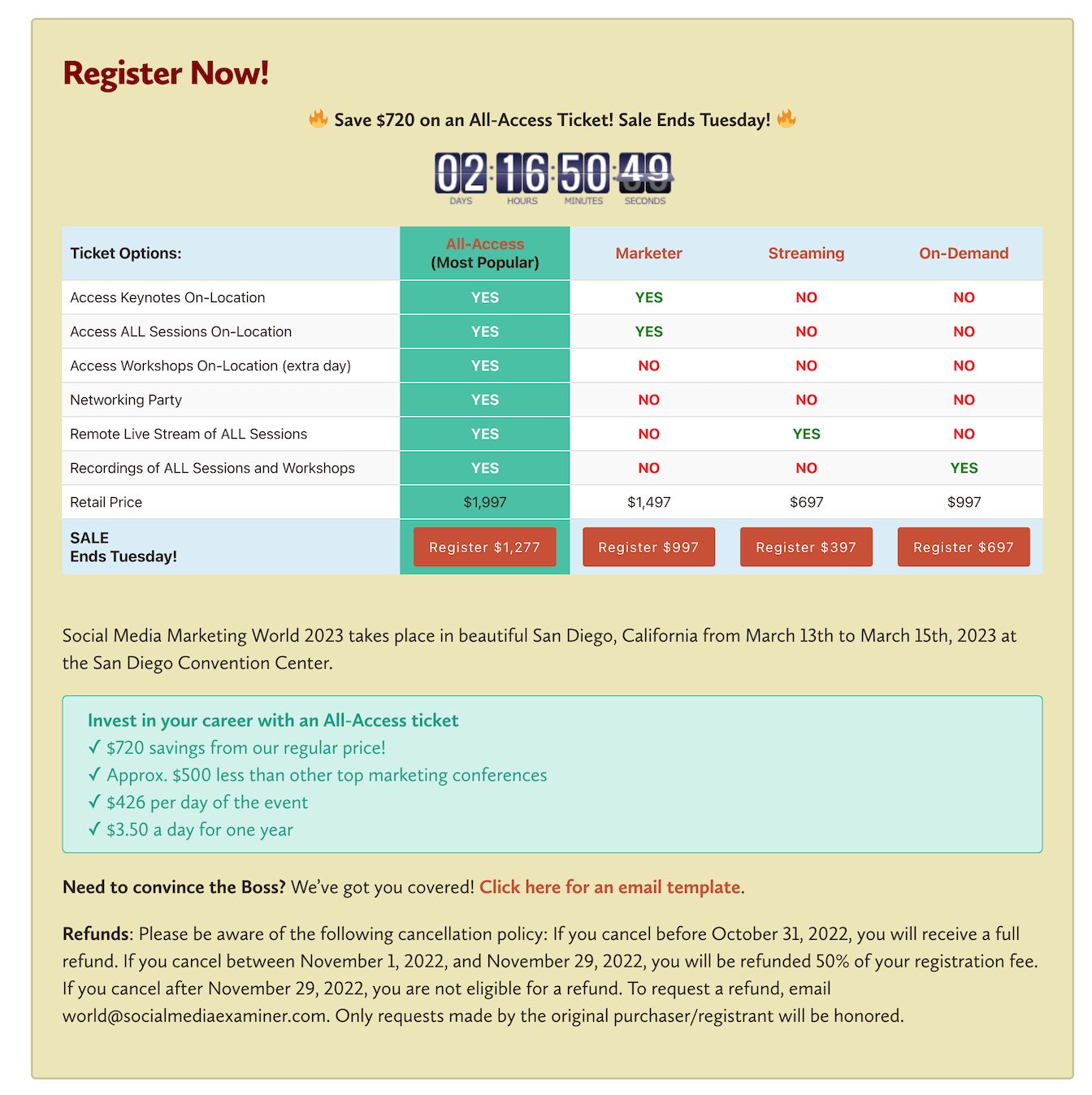 Source: Social Media Marketing World
Source: Social Media Marketing World
Step 5: Wrap Up and Measure Event Success
Congrats on creating a successful event! But your work isn’t done quite yet. Now, it’s time to make sure all of your loose ends are tied up. Here’s what you need to do.
Send a Thank You Email
Send out a thank you email to your attendees and stakeholders. Your event wouldn’t have been possible without people attending and stakeholders supporting it. Make sure they know that. Using email segmentation, launch an email blast to all your attendees. Depending on the sophistication of your event software integrations, you may be able to fine-tune email segmentation based on ticket type, sessions attended, and more.
Evaluate Event Success
You established your event for clear goals. Now, it’s time to look over your event data to see how successful your event was. Whether your event KPI for the event was registrations, pipeline generated, revenue generated, or simply attendee satisfaction, it’s time to dive into your event analytics.
If you’re using event software, you should be able to clearly visualize all of this information from the event dashboard.
If you want a deeper look at the most important KPIs for measuring event success, check these 23 out.
Evaluate Event App Analytics
If you’re using an event app, you’ll want to see how people used it to determine whether or not it was worth the investment by asking the following questions:
- How many people downloaded your app?
- How many people used it?
- How many messages were sent?
- How many connections were made?
- How many meetings were scheduled?
- Did sponsors get the anticipated amount of leads?
Want to do more with data? Listen to this episode the Event Experience podcast featuring The Event Strategist herself, Nicola Kastner: Developing a Data-Driven Event Strategy
Send Out Event Surveys
After the event, allow attendees to speak about their experience, what they liked, and how they think your next event can be even better. A post-event survey with open-ended questions is a great way to get this type of feedback, but you also may want to use NPS (net promoter score) — one of the best tools at your disposal.
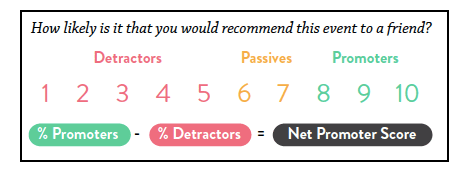
This survey asks a straightforward question: On a scale of 1–10, how likely is it that you would recommend this event to friends?
- Scores of 9-10 are considered “promoters” who will act as loyal enthusiasts for your event brand.
- Scores of 7-8 are “passives” who are satisfied attendees but are still vulnerable to competitive offerings.
- Scores between 0-6 are considered “detractors” who risk damaging your event brand through negative reviews.
NPS is then calculated by subtracting the percentage of detractors from the percentage of promoters. This score is a key indicator of how much value your event brought to attendees, which is something all major stakeholders will want to know.
But also, consider reaching out to the most active and engaged attendees to find out what they liked, what they’d like to see different at the next event, and other qualitative feedback questions. It’s essential to get a balance of quantitative and qualitative feedback so you can calculate the true success of your event.
Want to scale your event strategy? Read “9 Ways To Successfully Scale Your Event Strategy.”
Building a Stronger, Better Event Strategy: Key Takeaways
If there’s one thing to take away from this extensive guide, it’s this: Your event goals are crucial to building a successful event strategy.
Your event goals create the foundation for everything — from your event promotions to your success metrics to your event brand. Having concrete goals gives you the direction to proceed with your event strategy timeline and will help you determine the best tools for getting the job done — in 2024 and beyond.
Here are our key takeaways when strategic event planning:
- Identify your event goals and KPIs
- Choose event technology that can help you achieve those goals
- Create a consistent, branded event journey
- Find the right partners and sponsors to enrich your event
- Curate your event content for an engaging experience
- Communicate regularly and thoughtfully with your audience
- Measure, evaluate, and pivot for more successful future events
If that means leveraging out-of-this-world event software, we’re here to help. Click the button below to connect to a product expert and discover how Bizzabo can take your event strategy to the next level.
Want to start by evaluating your event strategy? Read “A Guide for How To Evaluate Your Event Strategy.”
Editor’s note: This post was originally published in December 2019 and has been updated for relevance.

